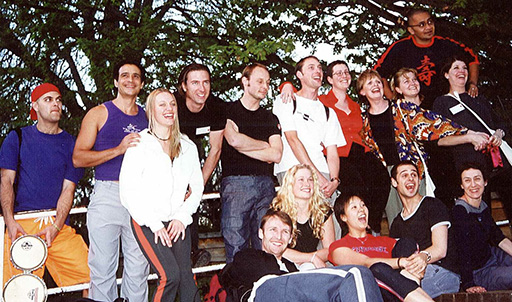While turning the big 40 can provoke anxiety, soul-searching and the purchase of sports cars in humans, for an organisation to reach this marker is a cause for unadulterated celebration. This year marks this milestone for Ausdance, Australia’s national body for dance advocacy, education and outreach. First established in 1977 as the Australian Association for Dance Education (AADE) in Melbourne, Ausdance’s mission was to provide a united voice for Australia’s burgeoning dance community. Over these last four decades the accomplishments of Ausdance have been as varied as they have been numerous but the goal has remained the same: to educate, inspire and support the dance community to reach its potential as a dynamic force within local, national and international communities.
One of Ausdance’s early goals was be a truly representative national organisation. To this end, in 1977 regional offices were established in each state and territory. In these early days, the running of these centres was left largely to volunteers. Ausdance has been incredibly fortunate over the years to have benefitted from a swag of passionate volunteers, keen to foster Australia’s dance education and creativity. In 1978, a national constitution was adopted at a meeting in Adelaide, followed by the first biennial dance education conference in Sydney in 1979. Education has always been at the forefront of Ausdance’s mission—whether consisting of the formal discipline of dance education or the education of the public about the role of dance within our culture.
Ruth Osborne was there from the beginning. Back in 1977 she had moved from Sydney to Perth to establish the Contemporary Dance Centre. Once in Perth, Osborne was one of the key players who worked to establish the WA branch of Ausdance. I catch her on the phone in Northern England, one of several locations she’s been in the last few weeks as part of a coveted Churchill fellowship. ‘Right from the beginning, the “tribal elders” who founded the AADE wanted to create a truly representative organisation’, Osborne explains.
Being in Perth, on that side of the country, there is a real tendency to feel isolated and out of the loop. The creation of Ausdance was really vital in ensuring that the smaller states were included in what was a very exciting scene.
These days Osborne is back in the East, as Artistic Director of Canberra’s QL2 Dance, but her ties to the West remain strong. 'I was there for a long time—at the Contemporary Dance Centre and STEPS and then WAAPA—and I vividly recall how important Ausdance was in making sure the less populous states had a voice on the national dance stage.'
Those who led the charge in founding Ausdance reads a bit like a who’s who of Australian dance history—Dame Peggy Van Pragh, Shirley McKechnie OAM, Keith Bain OAM, Dr Warren Lett, Dr Peter Brinson, Hanny Exiner and Donna Greaves. All of these people were based in the centres of Melbourne or Sydney so, in retrospect, it’s a bit fabulous and unlikely that the organisation has always been so fiercely regional.
 Ruth Osborne (standing far right) with tutors at the 2001 Australian Youth Dance Festival in Armidale, NSW.
Ruth Osborne (standing far right) with tutors at the 2001 Australian Youth Dance Festival in Armidale, NSW.‘Ausdance has certainly meant different things to different parts of the country’, says Ruth Osborne. ‘You could certainly argue that it has had a more prominent position in the smaller states because it performs a more vital role of keeping those states in on the action. One of the really wonderful and unique things about Ausdance—even today—is that the different offices have very different roles.’
So, does Osborne think that the existence of an organisation committed to dance advocacy has been influential in terms of creative output?
Absolutely! Those less populous states have incredibly fertile dance scenes and I honestly think Ausdance played an instrumental role in creating that. By encouraging the best in dance education; by lobbying governments and providing dance with a real voice (and therefore funding); by supporting independents. When you consider these achievements as well as the endurance of events like the Australian Dance Awards, the Australian Youth Dance Festival, the National Dance Forum and the Safe Dance Reports, Ausdance has been really critical to the health of our sector. You can see it now too in the regions...it’s in the smaller centres where the benefit of having a strong organisation like Ausdance is particularly clear.
And perhaps this is the real reason we should all be celebrating Ausdance’s 40th birthday with gusto. Coming off the buzz of a big event like the recent National Dance Forum, it’s easy to be dazzled by the rhetoric and aspirations, but maybe the unique value of Ausdance lies in the incremental, sustaining pulse of activity all around Australia. 'Ausdance takes dance everywhere...from the big cities to unexpected corners', says Osborne. 'And that is definitely something to celebrate.'

